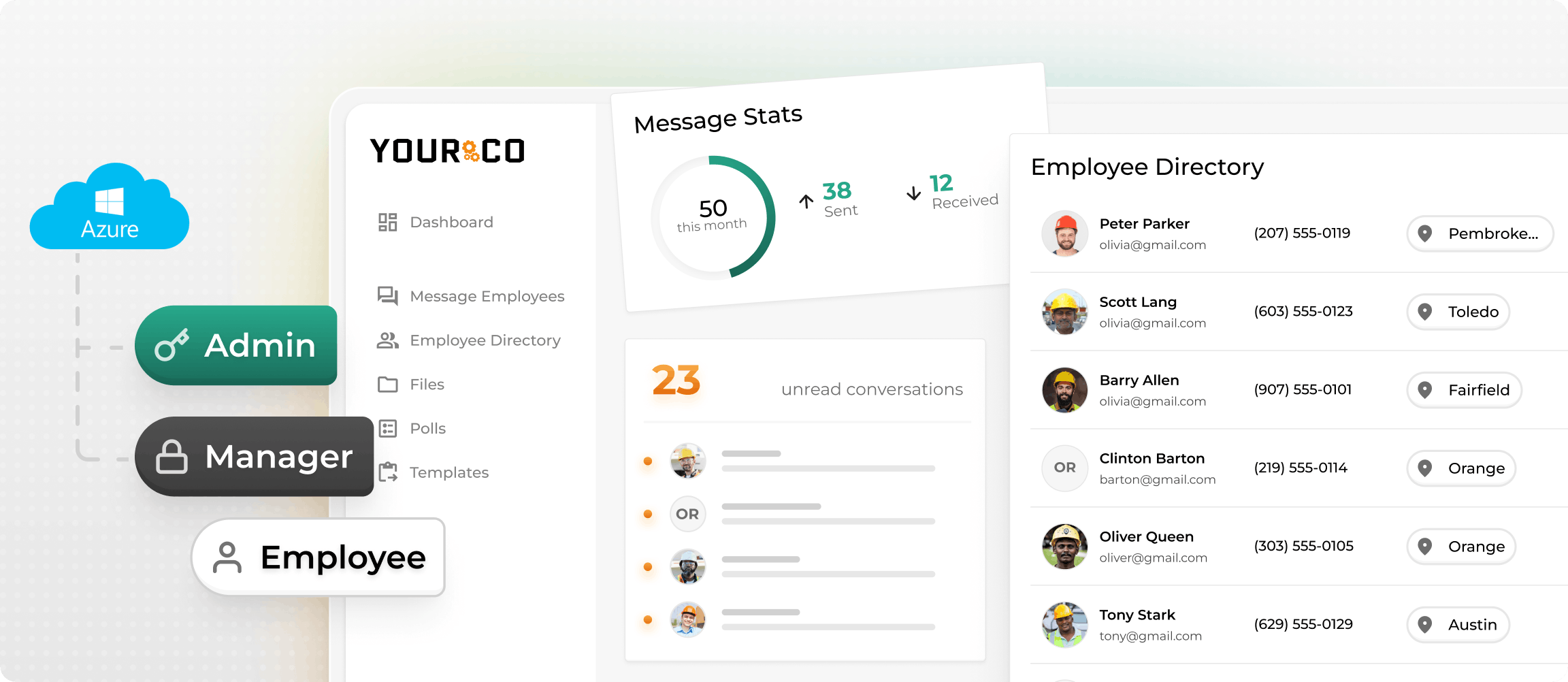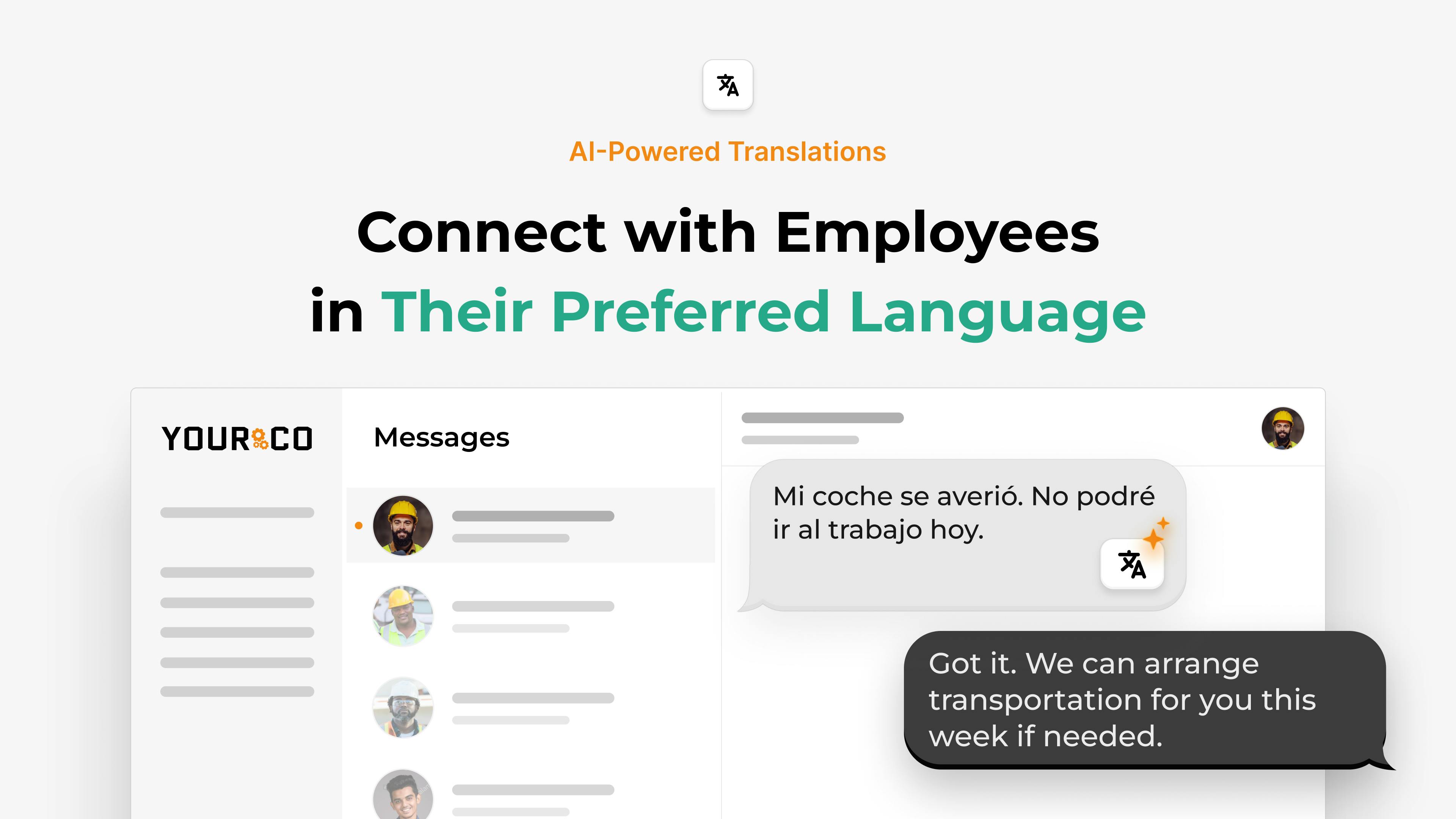Unionized Workforces and Call-Off Communication: What HR Leaders Should Know


Managing absences in a unionized workplace isn’t just about covering shifts. It’s about building trust, keeping communication clear, and making sure every employee is treated fairly. When everyone follows the same process and records stay organized, you avoid confusion and protect both sides.
This guide walks through simple ways to make call-off communication smoother, from setting clear expectations to using real-time tools that keep your team connected and compliant.
Understand Union Contracts and Call-Off Rules
You can't manage absences in a union shop unless you follow the contract and keep records that prove it.
Follow Approved Notification Methods
A call-off procedure is simply how your employees tell you they'll miss a shift. Most union contracts spell out every step: how they send the message, when it must arrive, and what details to include. Some contracts even name specific phone numbers or allow texts, but only if they reach a supervisor first. These approved methods are clearly listed in many agreements, such as federal contracts that specify phone, email, and text as valid ways to report absences.
Meet Strict Timing Requirements
Timing rules are just as strict. Most contracts require notice at least one hour before the shift starts or "as soon as possible" for emergencies. Employees must explain the reason, share when they expect to return, and after several days, provide a doctor's note.
Apply Discipline Consistently
Most union contracts include progressive discipline: verbal warning, written warning, suspension, then termination, applied step by step to keep punishment fair and open to grievance procedures. Inconsistent enforcement creates problems. If one supervisor ignores the deadline but another writes people up, that uneven treatment can hurt your case during arbitration.
Make Rules Accessible to Everyone
Make the rules easy to find. Post a simple summary in every break room, put it in each supervisor's handbook, and translate it for teams that speak different languages. Keep ordinary call-offs separate from protected leave. When an absence involves FMLA or disability rights, limit contact to essential updates and protect medical information. Clear, consistent steps keep you compliant and prevent small absences from becoming major disputes.
Standardize Communication Across Every Shift
Clear, uniform communication prevents avoidable grievances while maintaining fair treatment across every site. When you manage multiple plants, warehouses, or crews with rotating supervisors, policies can drift. One manager might accept a voicemail at 5 a.m. while another insists on written notice. These small differences create openings for contract disputes and claims of unfair treatment. Here’s how to standardize communication:
- Publish identical, plain-language procedures at every location, right down to confirmation message wording
- Brief new supervisors on union relations on day one so practices stay consistent during staff changes
- Route every absence through one company-wide SMS channel that works on any phone
- Let text-first communication reach off-shift managers faster than email or voicemail
- Create complete audit trails with searchable message histories that show what was said, when, and by whom
- Hold regular check-ins with stewards to gather union feedback and confirm fairness
Since texts get read within minutes, centralized systems help you arrange coverage quickly.
Document Every Absence for Audit Protection
When attendance disputes arise, solid documentation often settles things quickly. Clean, time-stamped records of every absence give you the evidence you need before conflicts escalate. For each absence report, capture these essentials:
- Date and exact time the message arrived
- Employee name or ID
- Reason given for the absence
- Expected return date, if offered
- Name of the person who received the report
- Confirmation that the employee got your response
Handwritten phone logs and voicemail create unnecessary risks. Entries get lost, handwriting becomes unclear, and follow-up notes scatter across different systems. Digital systems solve these problems. When an employee texts an absence through an SMS-based tool like Yourco, the message gets captured instantly with automatic time stamps and searchable records. Those records stay accessible for audits, contract negotiations, or any legal review.
Real-time notifications add another layer of protection. As soon as an absence enters the system, supervisors see an alert, HR gets a copy, and the record locks against later changes. Instant notifications mean you can pull the exact message thread months later and demonstrate fair, consistent treatment. Thorough documentation protects everyone and speeds up resolution when questions arise.
Respond Clearly and Respectfully to Call-Offs
A quick, respectful response makes all the difference when an employee reports an absence. Clear, neutral language shows both the employee and union that your process treats everyone fairly. Something simple like "Thanks for letting us know about today's shift. We've updated the schedule. Just let us know when you expect to return" keeps things calm and meets contract requirements for confirmation.
Use Standardized Response Templates
Standardized templates take the guesswork out of these conversations. When every supervisor uses the same wording across shifts and sites, you avoid mixed messages that can turn into grievances. Templates also help managers stay away from tricky territory. Asking too many questions during protected leave can look like interference and lead to FMLA violations.
Send Immediate Confirmation
Always send a receipt confirmation. That time-stamped record proves the absence was logged properly and stops arguments about whether the employee followed procedure. It also gives workers peace of mind that their message reached the right person, cutting down on follow-up calls.
Support Multilingual Teams
For multilingual teams, clear communication goes beyond just tone. Translation features or bilingual templates help every employee understand the process. This matters because language barriers already cost companies productivity and create safety risks. Run your templates by union representatives first. Their feedback helps you get the wording right before problems pop up.
Activate Real-Time Alerts to Cover Shifts Fast
When someone reports an absence at the last minute, you need to know right away. Missed voicemails mean scrambling to find coverage while your team wonders where their coworker is. Text-based alerts reach every supervisor and HR partner instantly, so you can line up replacement workers while operations keep running smoothly.
- Read SMS messages within minutes with a 98% read rate that beats every other method
- Confirm absences and start replacement plans before shift confusion spreads
- See which slots are open and which standby workers are available the moment someone logs an absence
- Assign overtime fairly and keep wage costs under control
- Give employees instant confirmation that their absence was recorded correctly
- Create automatic paper trails that include exact time, date, reason, and acknowledgment
This level of visibility turns last-minute call-outs into quick, organized responses that keep every shift fully staffed and stress-free.
Sync Call-Off Steps with Union Agreements
Your attendance policy and the absence language in your collective bargaining agreement need to match word for word. When these documents don't align, supervisors end up guessing how to handle situations, grievances start piling up, and trust between management and workers breaks down.
Review Documents Regularly
Get into the habit of reviewing both documents every quarter and always right after contract negotiations wrap up. A quick legal review prevents new language from conflicting with existing rules, while union orientation guides help new managers understand updates before they're put to the test.
Simplify Complex Contract Language
Turn complex contract clauses into simple, one-page summaries that you can share with stewards and post in break rooms. Clear side-by-side tables or flowcharts eliminate confusion and show employees you're committed to transparency. When any procedure changes, document the adjustment, get union sign-off, and store the record in a shared folder. These strategies prevent "he said, she said" disputes down the road.
Maintain a Single Source of Truth
Keep every absence request in a searchable log. SMS tools that automatically timestamp messages and reasons give both sides a single source of truth. When contract language changes, update your auto-reply templates at the same time so employees always see current procedures and you stay aligned with the CBA.
Equip Supervisors to Handle Absences Fairly
Your absence reporting policy only works when every supervisor applies it consistently. Start with the basics: train supervisors to log every absence with the time, reason, and confirmation. Time-stamped notes protect you during grievances and support progressive discipline steps like verbal warnings, written warnings, and suspensions found in most attendance policies.
- Coach supervisors on neutral, factual tone to prevent bias claims and keep interactions professional
- Give them simple scripts to practice for consistent responses across all situations
- Role-play scenarios with new supervisors to help them stay calm when employees are upset
- Schedule refresher training after contract updates to review policy changes
- Rehearse challenging situations like multiple short-notice absences or suspected leave misuse
- Remind supervisors to avoid asking for medical details that could cross privacy boundaries
Well-trained supervisors keep absence reporting rules strong and disputes minimal. A simple response like "Got your message, Jamie. You're marked absent for today, 7 Oct. Let me know by 4 p.m. if you expect to be out tomorrow. Hope you feel better" shows professionalism without triggering interference claims.
Remove Language Barriers from Absence Reporting
When your crew speaks several languages, a missed word can lead to grievances or safety risks. Clear absence reporting instructions protect everyone.
- Print and post absence reporting steps in every language your team uses
- Keep the wording simple: who to text, by when, and what details to include
- Add a basic flowchart so employees with limited reading skills can still follow along
- Send the same instructions by text message to reach workers who don't check email
- Use automatic translation to remove confusion and create records in both languages
- Design messages that work on any device without requiring downloads or data plans
Before rolling out changes, review the messages with union stewards. Their input helps ensure every phrase makes sense, reducing the chance an honest mistake becomes a formal dispute.
Prevent Absences Before They Disrupt Production
Stop firefighting and start planning. When you head off absences before they hit the schedule, you protect production, morale, and labor relations all at once.
- Send quick reminder texts an hour or two before high-absence shifts to nudge forgetful employees
- Reach everyone fast with SMS messages that get read within minutes, even without smartphones
- Spot patterns with time-stamped data showing which shifts or routes see more absences
- Adjust staffing, rethink rotations, or offer voluntary overtime where it counts most
- Invite workers to text back scheduling concerns rather than waiting for formal grievances
- Recognize good attendance publicly while addressing root causes like fatigue privately
Keep the tone supportive, not punitive. A transparent, data-driven approach shows employees and union stewards that you're solving problems together, not just policing them.
Automate Fair Call-Off Documentation with Yourco
If you want fewer grievances and faster coverage, give supervisors one simple channel that works for everyone. Yourco uses plain SMS, so employees can report absences from any phone, without apps or data. Messages are read quickly, confirmation receipts go back to the employee, and every interaction is time-stamped and searchable, which supports consistent, contract-aligned treatment across sites.
Yourco’s AI-powered translations support 135+ languages and dialects, making the process clear for multilingual teams. Send one message and it’s delivered in each person’s preferred language with replies translated back for managers. That removes guesswork, reduces escalation risk, and helps stewards see that the rules are applied fairly.
On the operations side, HR and supervisors get instant alerts the moment a call-off arrives. Because Yourco integrates with 240+ HRIS and payroll systems, rosters and preferred languages stay current, so notifications reach the right people fast. Role-based permissions and encryption protect sensitive information, while automatic logging creates an audit-ready paper trail you can reference in minutes during reviews or bargaining.
Bottom line, Yourco turns call-off chaos into a clear, repeatable workflow from the first text to the final record so you can maintain fairness, meet documentation expectations, and keep production running.
Try Yourco for free today or schedule a demo and see the difference the right workplace communication solution can make in your company.
Frequently Asked Questions
How can HR ensure call-off procedures align with CBAs?
Start by creating a simple checklist that maps every attendance rule in your contract to clear, written steps. Share this with supervisors and union stewards, then review it together after each contract negotiation. When everyone uses the same language and follows the same process, you avoid mixed messages that turn into grievances.
What's the best way to document absences for grievance protection?
Use a digital system that timestamps everything automatically. Make sure supervisors record who was absent, when they reported it, why they're out, when they'll return, and who took the message. When disputes come up, having complete records with exact timestamps protects you and shows you treated everyone fairly.
How can multilingual teams avoid miscommunication during call-offs?
Give everyone step-by-step instructions in their native language. Test understanding with quick role-play sessions so you know the message got through. SMS tools like Yourco that translate messages instantly let employees report absences in their preferred language without confusion.
What records should HR maintain for compliance?
Keep a searchable file that shows the date and time of each absence report, who was absent, why they're out, how long they'll be out, who received the message, and any supporting documents like doctor's notes. Complete records make audits easier and protect you during disputes.
How do real-time messaging systems improve call-off handling?
Instant alerts help you find coverage before production stops, while automatic records protect you if disputes arise. Since most people read texts within minutes, SMS-based systems close coverage gaps fast and prove you responded to every employee fairly and quickly.




